- Update on existing recommendations - take profit on SEK 2Y versus EUR widener.
- SEK: dark clouds.·
Trades
New: Buy SGB10536 (Mar 2039) against paying the 10Y swap, while paying the 5Y swap and receiving the 2Y swap. The box trades at around -15bp. P/L: -35bp/-2bp.
Profit taken: Pay SEK 2Y2Y SEK veruss EUR. Profit 7bp.
Loss taken: Steepen 2Y-5Y in SEK swaps. Loss 10bp.
Danske Bank’s Market View In A Nutshell
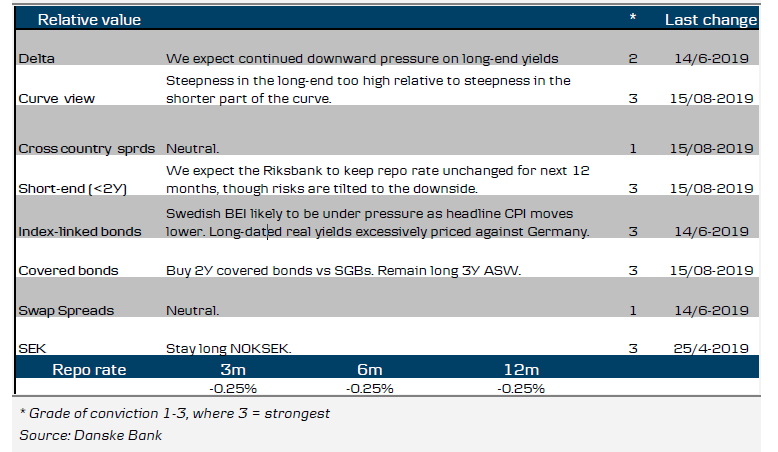
Is the SEK market wrong pricing a rate cut?
One could ask the above question given that inflation has come in on the high side of the Riksbank’s forecast for the past couple of months (in July the deviation was +0.2 y/y for CPIF and almost +0.1% y/y for CPIF excluding energy). However, we think the answer is no. First, the deviation is really too small to be meaningful. Second, the Riba-contract between October and April prices in a total of 10bp, which we do not see as exaggerated.
Third, there is a lot of new information for the Riksbank to consider at the next monetary policy meeting. In practice, the big uncertainty for the Riksbank now is whether the inflation projection is realistic in the medium term.
In the international area, it is now a fact that the Federal Reserve eased in July and very likely that the ECB will add stimulus in September. At the July policy meeting, Governor Stefan Ingves said ‘but there is a risk outlook, as I mentioned earlier. If the markets are right, the major central banks may turn their monetary policy around, into a more expansionary direction. If this is the case, we will need to take a stance at our future monetary policy meetings on what it means for monetary policy in Sweden.’ Then again, he also underlined that monetary policy in Sweden has more degrees of freedom now than a few years ago.
Still, central banks from the Fed and ECB to those in New Zealand and India adding stimulus tells us something, namely that the global economy is slowing down, and this is important for Sweden. In addition, trade tensions between the US and China, which looked a little better after the G20 meeting, have intensified again. In addition, the risk of the UK crashing out of the EU increases by the day. Ongoing political turmoil in Hong Kong and problems in Argentina are perhaps distant issues but are still issues. The July minutes contained much discussion about international bond yields having fallen significantly since the previous meeting, signalling worsening financial market sentiment. Rates have fallen another 25-30bp since the July policy meeting. Overall, the global outlook appears worse. Domestically things have happened too. In our minds, the most significant piece of information is that we now have robust evidence that the labour market has turned the corner. Private businesses’ hiring plans are cooling off. According to SCB, overtime was down by 15% y/y in the second quarter and for the first time in 10 years, employment has registered two consecutive quarter-on-quarter declines.
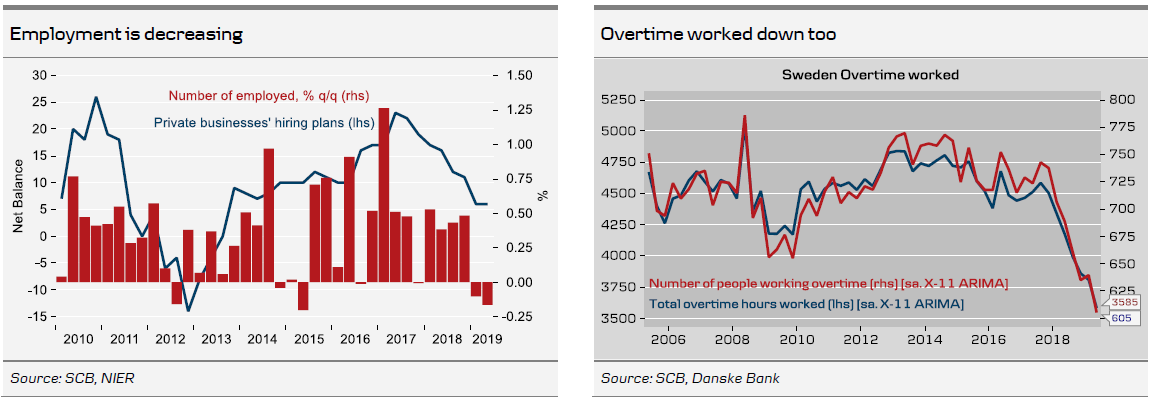
Deteriorating labour market conditions could have significant ramifications, including weaker spending power among consumers, headwinds for retailers and negative effects on state finances, as tax revenues slow and unemployment costs go up.
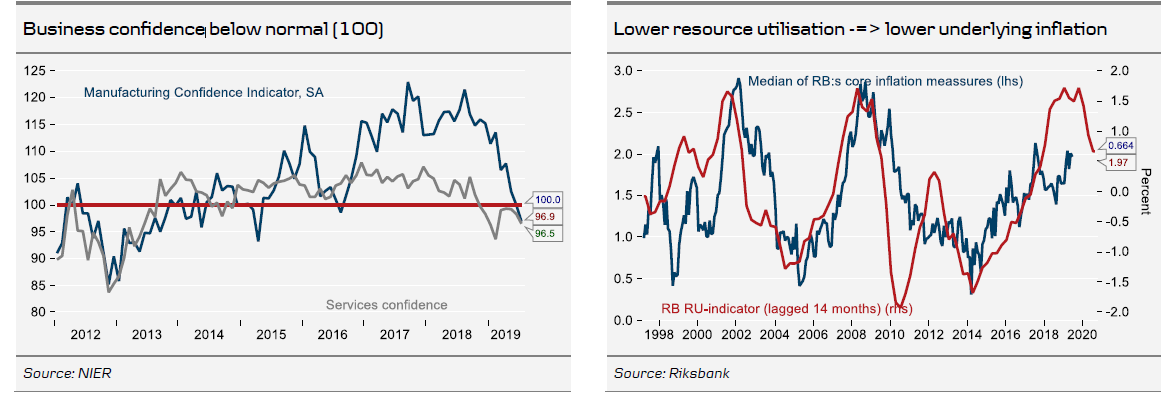
The recent signs from the labour market could potentially influence next year’s wage negotiations. Deputy Governor Per Jansson picked up this subject in July, saying that unless wages accelerate in line with the forecast, it could prove to be very difficult, perhaps even impossible, to keep inflation on target. We see more reasons to be worried about this. Although still at an elevated level, resource utilisation as measured by the Riksbank’s Resource utilisation (RU) indicator peaked in Q3 18 and has eased since. This could be of some importance for the Riksbank’s new preferred core inflation indicator, i.e. the mean of its various core measures. Historically, a similar move in underlying inflation has followed peaks/troughs in resource utilisation after approximately one year.
In addition, so far board members have noted that there has been a slight decline in inflation expectations without sounding much alarm. However, we do not think they are happy about the latest monthly (money-market) figures just released. CPIF expectations fell by a relatively large amount (1.62 2Y and 1.75 5Y). The CPIF survey has a short history, so to put the numbers into perspective, we need to look at CPI expectations. The latest figures are back to around the mid-2016 levels. The monthly survey is usually a good indicator of the broader quarterly survey.

What the market pricing is saying is that the skew of probabilities is to the next Riksbank move being a cut rather than a hike. We really do not think we are there yet but we do believe the updated repo-rate forecast will show the Riksbank on hold longer than currently expressed. Unless things turn for the better, we do think that a rate cut will eventually (say early 2020) become a serious possibility.
Long End Remains Too Steep: Flatten 10Y-20Y Vs. Steepening 2Y-5Y
On the back of lower international rates, 2s-5s have flattened massively and trade at a flattish 5 bps. In our view, the probability of inversion is relatively low as the room for medium-term rate cuts is limited. If fixing spreads remain well behaved (i.e. we do not expect the 3-month Stibor vs. repo spread to widen further), the downside potential should be limited. Spreads in the long end of the curve have moved lower as well, but not nearly to the same extent, see chart below.

This has pushed the 10-20Y versus 2Y-5Y box very close to the historical high (see chart below). The lower rate environment largely explains this. Thus, at first glance, it appears this box is basically a rate bearish trade.
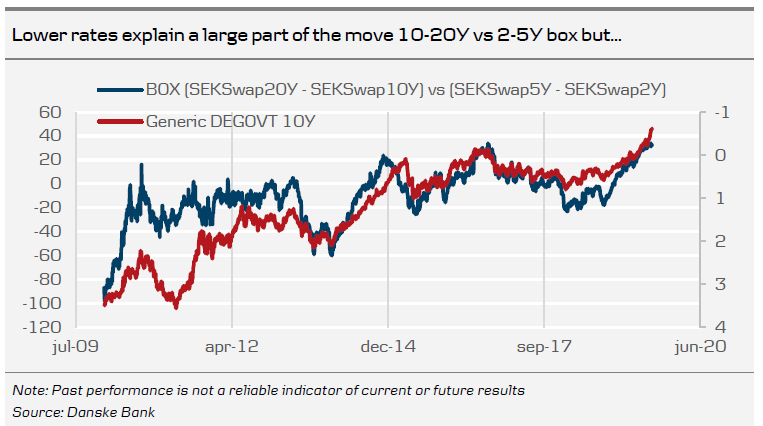
However, interestingly, the relationship between the rate level and the swap box seems to be on the verge of breaking down. Current box levels trade significantly below the regression line from January 2018. Simply put, 2s5s may have a hard time flattening further if rates move lower, while the longer end has more room to flatten. If instead rates move higher, it should expose the 5Y point and would be likely to underperform. Thus, we think this swap box looks toppish and like the risk-reward in receiving 10Y-20Y versus paying 2Y-5Y.
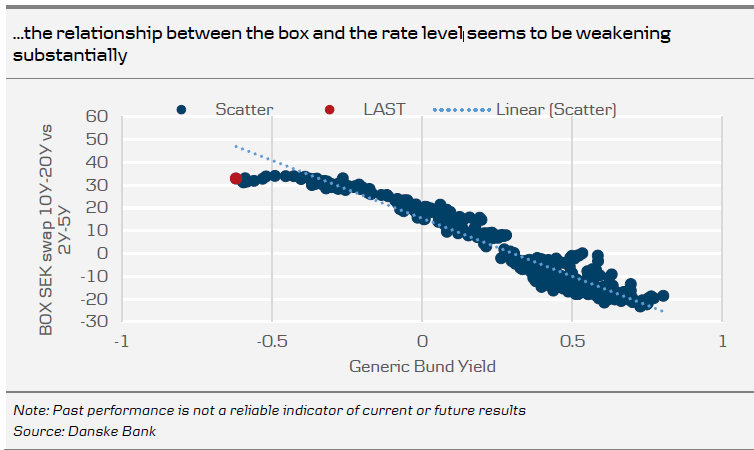
One could spice up this position further by substituting the 20Y SEK swap with SGB1053 (Mar 2039). The 20Y SGB bond has underperformed what we have seen in Germany and tail rates relative to the swap curve remain high.
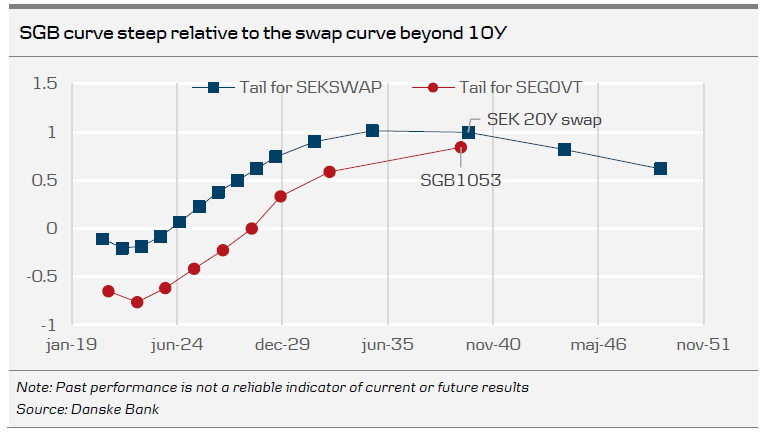
Thus, we recommend buying SGB1053 veruss paying the 10Y swap, while paying the 5Y swap and receiving the 2Y swap at -15bp. We set the P/L levels at -35bp/-2bp. Alternatively, a correlated trade would be to look at the 8Y versus 2Y/20Y barbell, which has historically tended to follow moves in the 20Y/10Y versus 5Y/2Y swap box.
A Word About July Inflation Data
Data (CPIF 0.41% m/m and CPIF excluding energy 0.19% m/m) came in close to forecast (CPIF 0.34% m/m and excluding energy 0.16% m/m). To mention some things that stood out, food prices came in significantly higher, while clothing was down more than we thought. However, food prices deserve a word. It appears that a new seasonal pattern has established since 2016, with food up significantly more in July than earlier but then lower in August. We are not sure why but it seems to be a pattern. Indeed, the 2.1% m/m in July this year is by far the highest on record going back to 1995, ahead of 1.3% m/m in July 2018. In August 2018, food prices fell by 0.4% m/m. Our August 2019 forecast for food (+0.25% m/m) no longer seems realistic. We cut this number to -0.5% and shave off a tenth from our CPIF forecasts for August, which are currently 0.3% m/m and 1.4% y/y.
Update On Existing Recommendations: Take Profit On SEK 2Y 2Y Vs. EUR Widener
We entered the recommendation to pay SEK 2Y 2Y against EUR 2Y 2Y ahead of the Riksbank’s meeting on 3 July, expecting a relatively hawkish Riksbank to show a reluctance to cut rates. This turned out in our favour and we saw a widening of the spread following the decision. However, in late July, Swedish data, such as labour market data and Q2 GDP, turned more negative, which dampened expectations of the Riksbank. During the rally in yields over the past two weeks, Sweden has lagged the EUR move and the spread is now trading at 37bp. Pressure on the Riksbank is now building and, unless things turn for the better, it may soon be forced to act, starting with an adjusted repo rate path at the September meeting. Hence, we choose to close the position at the current level with a 7bp profit.

We note that our short positions in Swedish breakeven have fared well over the summer. Given that we expect a more pronounced slowdown in inflation over the next few months, we believe there is further potential in these trades and keep both positions on. We note that the Prospera inflation expectation survey among money-market participants showed a rather pronounced fall in expectations in August. Currently, the survey-based inflation expectation is in line with market pricing, which historically has not been the case, as the market has traded BEIs markedly lower.
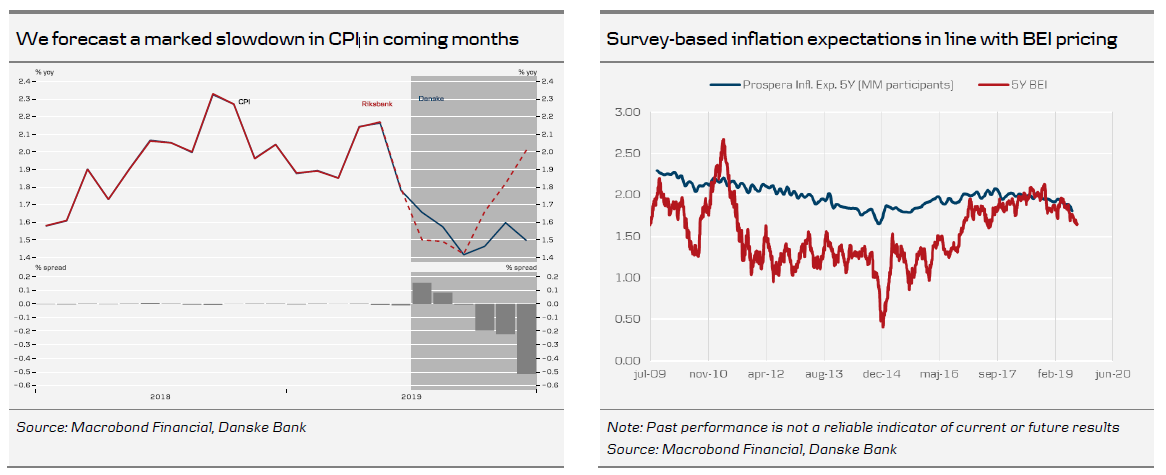
SEK: Dark Clouds
The SEK still faces multiple headwinds: (1) the global and Swedish growth slowdowns, (2) the escalating trade war, coupled with many other risks that weigh on risk sentiment, (3) the challenging domestic inflation outlook and (4) dovish pressure on the Riksbank, from both the economic outlook and the turnaround by other major central banks. While one tailwind for the SEK could be a waning appetite for carry trades in light of lower US yields and risk aversion, we doubt the SEK will be a persistent outperformer in such an environment.
Second-quarter GDP growth at -0.1% q/q and +1.4% y/y, the preliminary version, was a blow to the Riksbank’s expectations. Other data suggest that the downturn will continue into the second half of the year. In addition, the recent global developments may kill any remaining hopes that exports will be the savior when domestic demand falters. When the dark clouds are shaped by the escalating trade war, the situation for an export-oriented Swedish economy and the SEK goes from bad to worse.
Inflation data for July was on the high side of both consensus and the Riksbank but the path is unfortunately sloping downwards, away from the 2% target. Imported inflation was actually negative year on year despite the SEK. Falling inflation is a concern, not only by itself but also for ripple effects on inflation expectations. A number of Riksbank Board members raised concerns about a further decline in inflation expectations in the July minutes. For these, the continued fall in money-market expectations (Prospera) was certainly unwelcome. For once, the positive CPIF inflation surprise did not give rise to lower EUR/SEK, which instead ended the day higher. It suggests inflation data are temporarily somewhat in the backseat and dominated by (poor) risk sentiment.
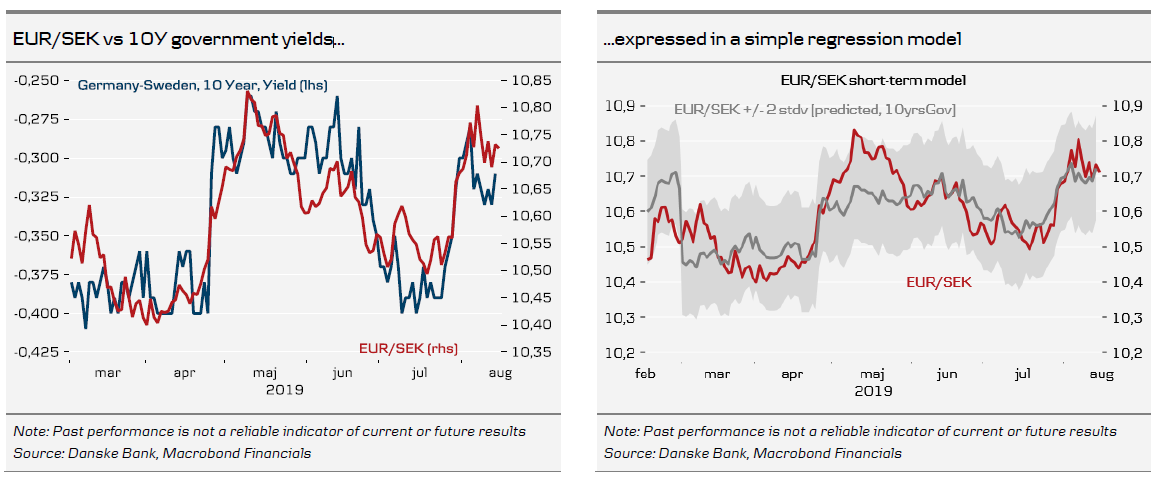
Despite soft messages and (back then) lingering cuts from the Fed and the ECB, the Riksbank stubbornly maintained its hiking bias in July. However, we believe it is only a matter of time before the Riksbank decides to postpone the next hike well into next year. In our opinion, it would make sense if it made that adjustment at the September meeting. Again, members of the Board said in July that if/when other central banks start to act, the Riksbank needs to take this into consideration. Given the current relatively soft pricing on the Riksbank, which in our view seems justified, such a decision may not lead to a significant rally in EUR/SEK. Still, it is hard to see how the Riksbank, despite its KIX forecast, will be a trigger for a stronger SEK any time soon.
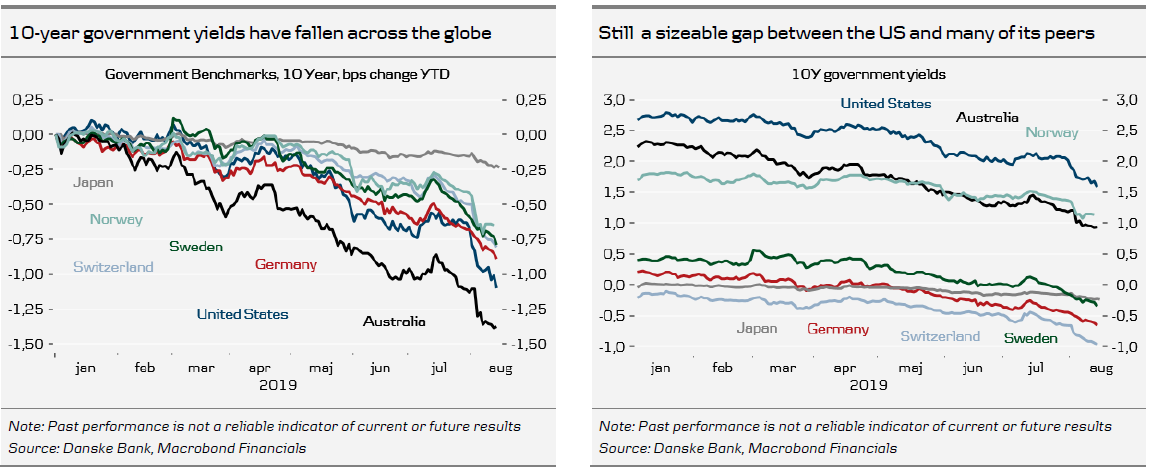
One can argue that with the Fed heading for a number of rate cuts, the appetite for carry trades will disappear and such positions will be scaled down (this has probably to some extent already happened). However, rates are down not only in the US but also in Europe. The 10-year government yield has decreased 110bp YTD in the US, 90bp in Germany, 80bp in Switzerland and 80bp in Sweden. Even Norway is down 70bp. While US spreads have narrowed, the USD still offers an attractive carry pickup. In addition, it still has elements of safe haven (alongside JPY and CHF). Over 2019, the 10Y spread between the US and Sweden has decreased by 30bp and, at the same time, USD/SEK has risen 75 figures. Speculation about the dollar’s demise seems greatly exaggerated.
To conclude, we stick to our bearish medium-term view on the SEK based on a cyclical economic slowdown, domestically and abroad, a subdued inflation outlook that will rechallenge the Riksbank and re-escalation of the trade war, coupled with numerous other dark clouds that weigh on risk sentiment. We see USD/SEK and EUR/SEK as buy on dips and remain comfortable with an upward-sloping trajectory for EUR/SEK, where we target the cross at 11.00 in 12M.
To read the entire report Please click on the pdf File.
